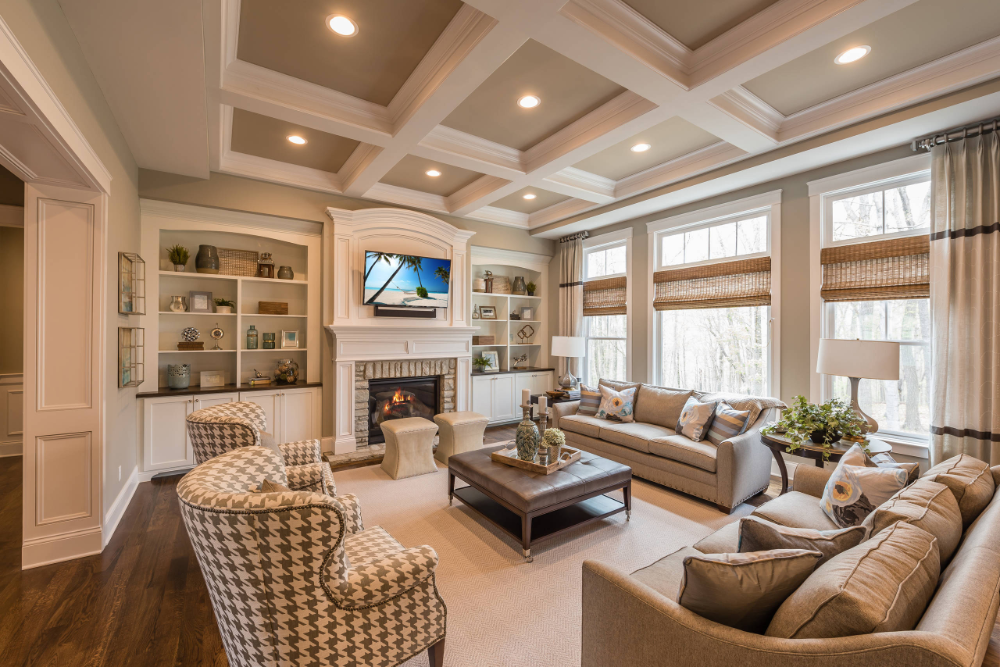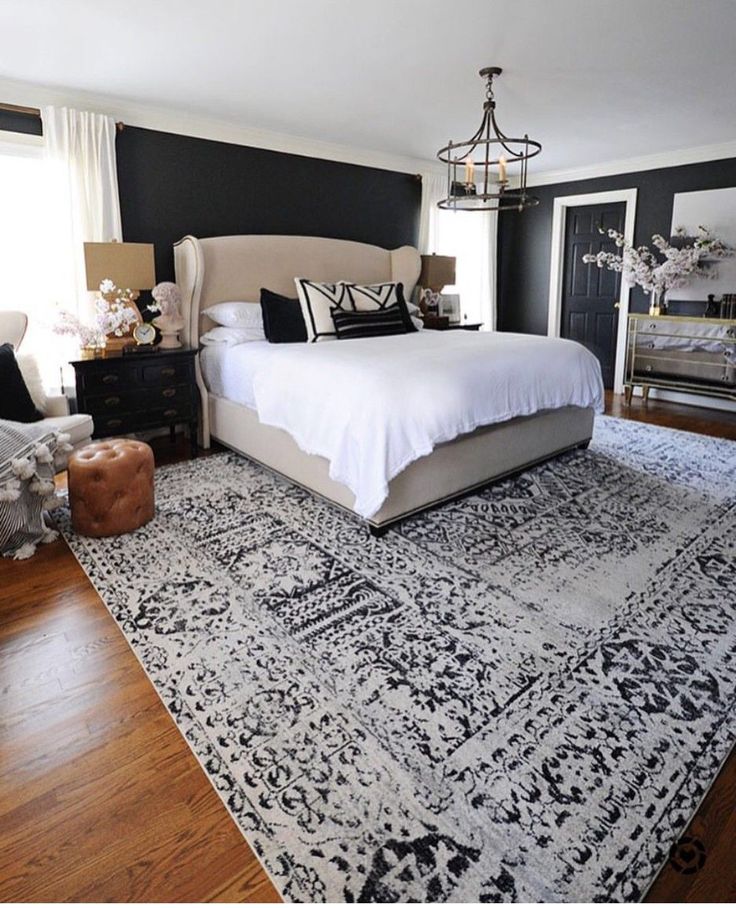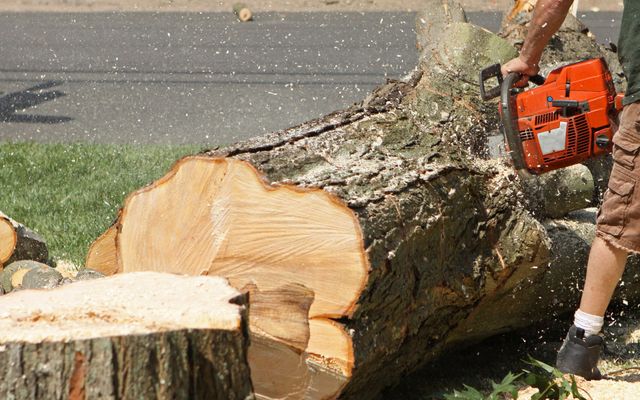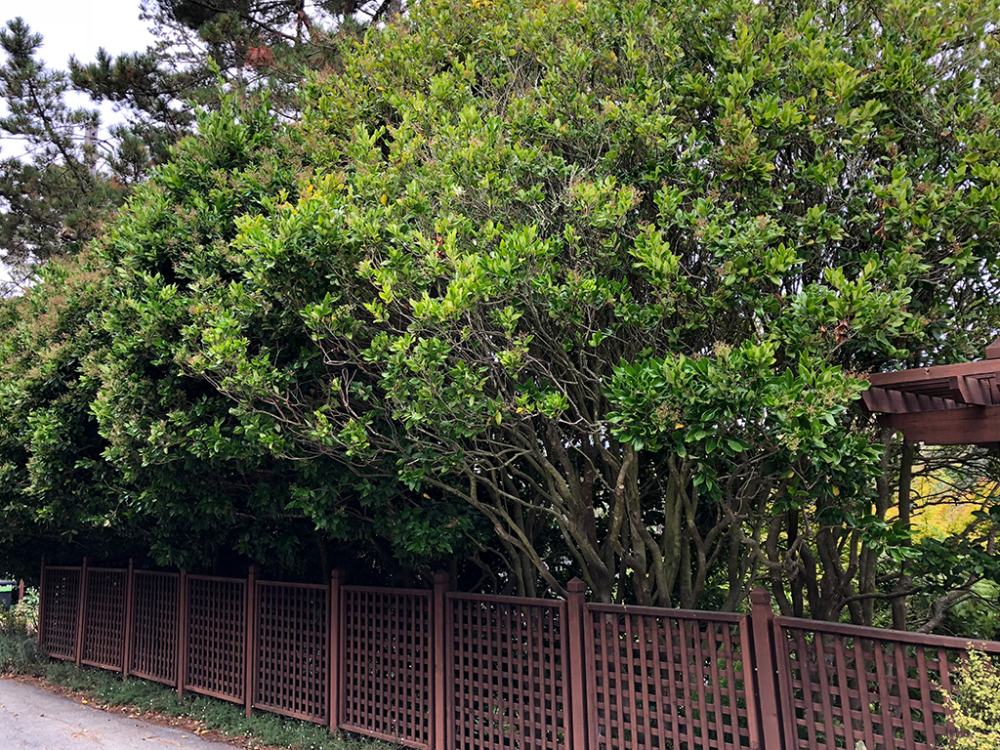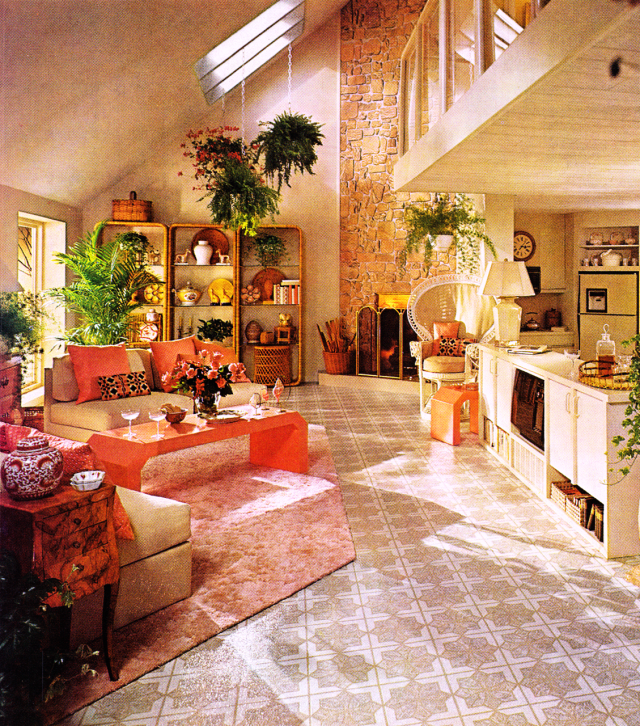Bookshelves organization ideas
5 Organizing Hacks for Library-Worthy Bookshelves
Design: Sarah Lyon, Photo: Lauren Zillinger for Laura Metzler Photo
Whether your home is filled with hundreds of different books or you've managed to whittle down your collection of reads to just a few dozens, you can likely agree that organizing a bookshelf to look both visually appealing and provide ample storage can be tricky. Is there a certain order in which books should be arranged? Is placing books in color order a major yes or a faux pas? What is the best way to style a bookshelf in a child's room?
To help answer all of these questions and more, we've consulted four professional organizers from across the country, who weigh in below regarding bookshelf organization techniques that are bound to wow you. After all, there's no reason that your at-home shelfie can't look majorly library worthy.
Keep reading for five top tips that the pros couldn't resist sharing.
01 of 05
Design: Sarah Lyon; Photo: Allie Provost
The way you proceed with arranging your bookshelf will depend on how you intend for it to be used. First, though, go through everything on the shelf and part with any books you anticipate that you'll no longer read, professional organizer Millie Naor suggests. Donate these titles and relish in the extra space you have to work with.
Whether a bookshelf is functional, decorative, or a mix of both will affect the next steps, Naor notes.
"If your bookshelf is more decorative, you can organize the books by color, mix different types of books together (fiction, non-fiction, travel, coffee table), and add different trinkets and decorative items on top or on the side of the books," she explains. "If you are looking for a more functional library, I would group the books by type, and then you could organize them by alphabetical order."
Looking to make a bookshelf both functional and decorative? "I recommend getting creative with the way you organize books," Naor says, and what we gathered from this? Think outside the box a bit.
"Put them back by type and organize them by size, space them out, make small piles of books with your favorite decorative items on top," she continues.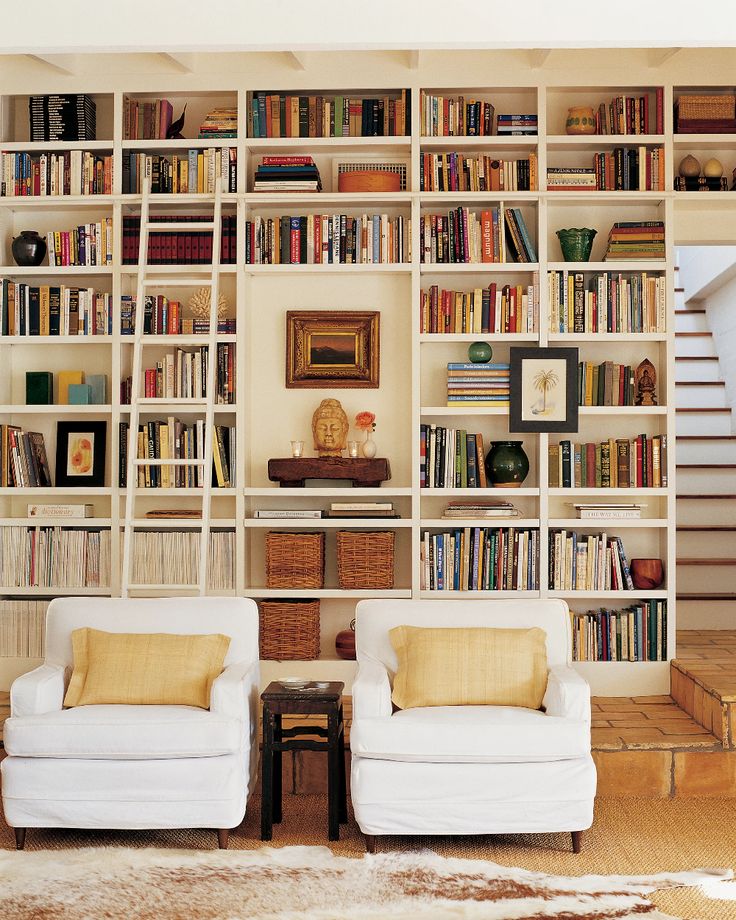 "With larger coffee table books, you can display them beautifully stacked on one another by size and color."
"With larger coffee table books, you can display them beautifully stacked on one another by size and color."
02 of 05
Design: Sarah Cole Interiors, Photo: Jared Kuzia
When organizing a bookshelf, you should keep placement of the various books top of mind, according to professional organizer Tracy Bowers. "Keep hardcover books separate from paperbacks," she encourages.
Once you've tackled this step, be thoughtful about where the books are actually set on the shelf. "Bring all the books forward with just about an inch or two of the shelf showing," Bowers says. "You want what you see to have a nice consistent clean line."
Keeping height in mind can also help you determine which books to place where professional organizer Joanna Wirick says. "When placing books on a bookshelf, arrange them shortest to tallest or tallest to shortest," she explains. "This creates a nice cascading effect. If you are stacking books horizontally, place the larger books on the bottom and smaller books on top.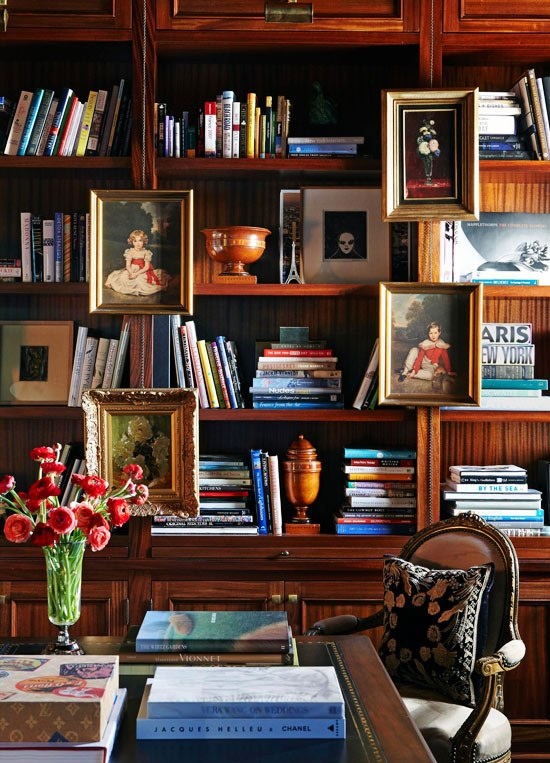 "
"
Feel like incorporating some decor onto your shelves? By all means, feel free, but note that there are a few techniques to keep in mind when styling. While people have many different views regarding the concept of arranging books by spine hue, Wirick is all for it, noting that if space allows, you can even designate a color for each shelf.
03 of 05
Joanna Wirick
Wirick suggests this tactic for bookworms in particular. "If you are an avid reader, write the date you finished the book on the inside cover," she advises. "Organize books chronologically by when you completed the book. This is an especially great tactic if certain books were read at special moments in your life."
04 of 05
Design: Sarah Lyon, Photo: Lauren Zillinger for Laura Metzler Photo
Let's face it—as is the case with actual library books, at least some of your reads at home most definitely show signs of wear. Not all books are as crisp and pristine as they look in styled photoshoots, after all.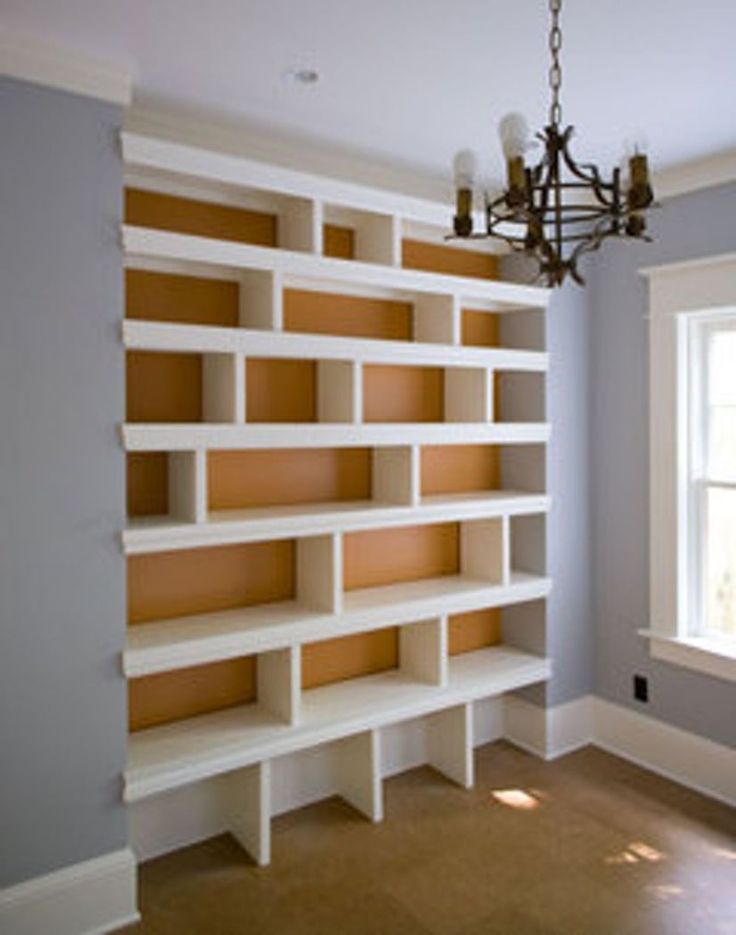
Wirick shares a quick tip for displaying reads that have seen better days: removing their hardback covers. Simply remove and recycle the original jackets to reveal the hardcover underneath.
Bowers agrees that removing book covers can result in a streamlined and elegant look. And bonus: most of the time, hiding beneath the book jacket is a stunning hardcover design most likely in a more neutral hue, giving your bookshelf a décor-focused look and feel.
05 of 05
Design: Rosanna Bassford, Photo: Laura Flippen
Designing a shelf for little ones? Professional organizer Kathryn Lord shares some tips specific to children's spaces.
"When thinking about children, you have to organize something so it’s easier for them to use," she explains. "Color-coordinating children's books will help children even as young as two, as they know what color their favorite book is even before they can read, and they know where to put it back."
Bowers agrees that color coding is a major go for young ones.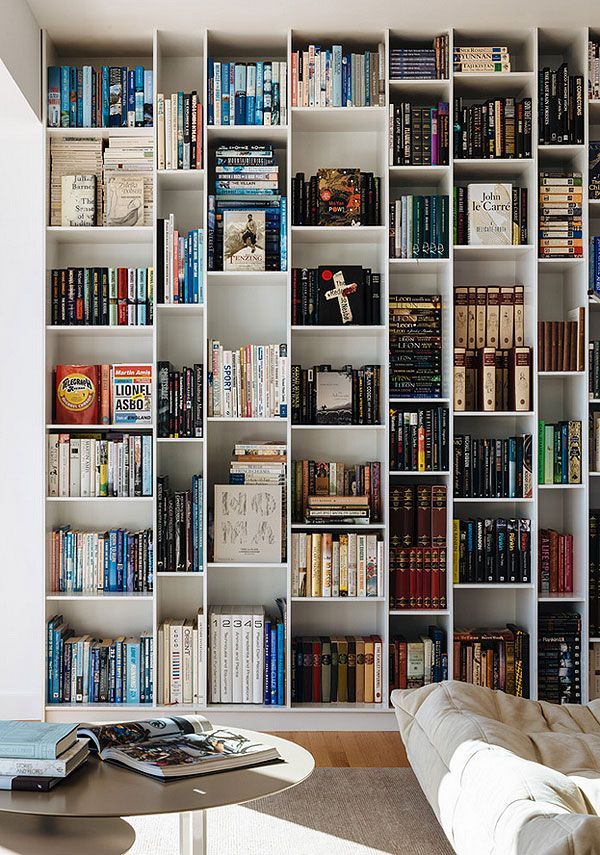
"Color coding is fun and looks pretty," she says. "But keep sizes together, arranging from tallest to shortest, within each color." Aesthetics and function? We're all for it.
Sorting books by topic is another tactic that can also be beneficial for young ones. "Themed books can support their learning," Lord adds. "For example, having all the books about ‘people who help us’, ‘elephants’ or seasonal themed books for Easter, spring, summer, etc."
In general, keeping the number of books set to a minimum won't just help a shelf stay more organized, it can also be helpful for children's focus.
"Too many books can cause overwhelm, so reducing the amount available and rotating means they will read a higher range of books than if they are all available all the time," Lord says.
11 of the Most Giftable Coffee Table Books We've Ever Laid Eyes On
15 ways to keep on top of your tomes |
When you purchase through links on our site, we may earn an affiliate commission.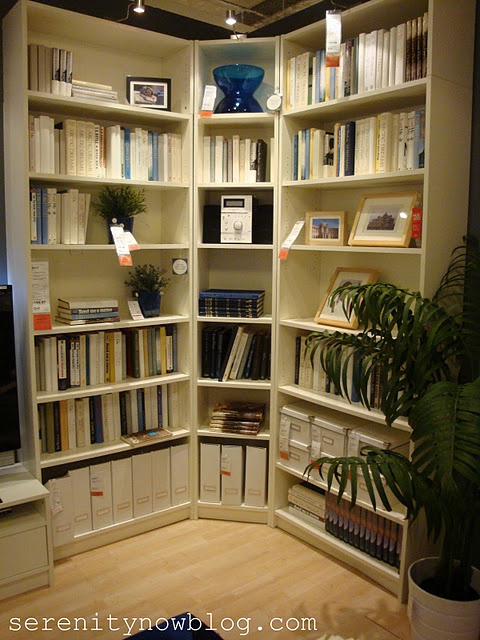 Here’s how it works.
Here’s how it works.
(Image credit: Future)
By Tara King
published
There’s no one-size-fits-all approach to organizing a bookshelf. Whether you sort alphabetically, by genre, in height order or something else entirely, if you can find what you need and you’re happy with how it looks, that’s all that matters.
As part of organizing a living room, good-looking bookshelves can truly lift the spirits – and encourage us to pick up a book more often too.
'Having books on display really adds a homely feel to any interior scheme. How you organize them really comes down to personal taste – there are no right or wrong answers,’ says Adam Brown, Director at The Painted Furniture Company .
Depending on how many books you have in your collection, organizing a bookshelf will likely take you the better part of an afternoon to do well. However, once you’ve decided on a system that works for you, it’s easy to keep it looking artful, particularly when complemented by meaningful keepsakes, photos and artwork.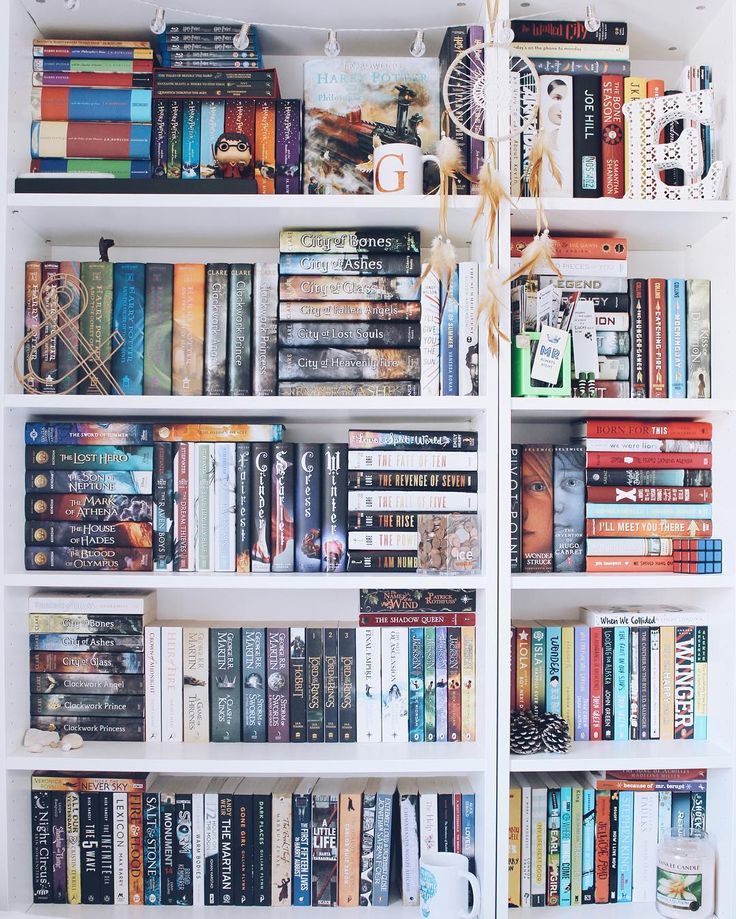
Organizing a bookshelf
We’ve compiled the best expertise to help you realize your bookshelf ideas and create a library-worthy level of bookshelf organization that’s not just practical to use, but beautiful to look at as well.
1. Edit your book collection
(Image credit: Future / David Lovati)
A common mistake when organizing a bookshelf is to try to fit in your entire book collection. This often results in a haphazard arrangement that makes it impossible to create orderly book storage ideas. Set yourself up for success by starting with a good decluttering session. Empty your shelves completely and give them a good clean.
According to the KonMari method, you should only keep books that bring you joy – everything else should be donated or gifted.
Most public libraries will accept book donations to sell at their semi-annual book sales, while children's books can go to area preschools and local school aftercare programs. Certain charities won’t accept books, so check in advance,’ advises home organizer Ben Soreff, founder of House to Home Organizing .
If you’re still struggling to decide, we recommend creating a ‘maybe’ pile. Position these away from your ‘keep’ collection temporarily, perhaps a week or two, somewhere you can easily see them, then take your time deciding whether to move any of them over to your main collection.
2. Order books alphabetically
There are several ways to order books, so think about what makes the most sense for your home library ideas. If it’s a bookshelf that you frequent regularly, we’d recommend an alphabetized system. It might not be the most creative way to arrange and organize books, but it certainly makes it quick and easy to find what you’re looking for.
If you’re alphabetizing based on the book’s title, you’ll likely have quite a few books that start with ‘A’ and ‘The’, so you’re best of leaving out the first word and organize based on the second word in the title instead. Be sure to let everyone in the household know to avoid any confusion.
Another option is to arrange alphabetically based on the author’s last name, like they do in bookshops and libraries. The only downside is remembering who wrote what… but if you’re someone who has a few favorite authors, this might be the system for you.
The only downside is remembering who wrote what… but if you’re someone who has a few favorite authors, this might be the system for you.
3. Group by genre
(Image credit: Sims Hilditch )
Whether you’re designing a home library, or you’re the sort of person who often picks books based on your mood, organizing books by genre is a great idea. You could keep it simple, fiction and non-fiction for example, or break things down into general categories: action, mystery, romance, fantasy and so on. There’s likely to be some cross-over, so keep a log of where you’ve filed your books for ease.
4. Create a rainbow effect
(Image credit: Future)
Organizing a bookshelf in order of color is not the most practical method but it’s certainly the most aesthetically pleasing and one way to style a bookshelf. Unless you’re someone who remembers books based on their covers, we’d recommend reserving it for bookshelves you don’t access very often.
To create a stylish ombre effect, organize book jacket colors from dark to light, bottom to top – black, navy and charcoal books on the top shelf, white on the bottom, with all the colors in between.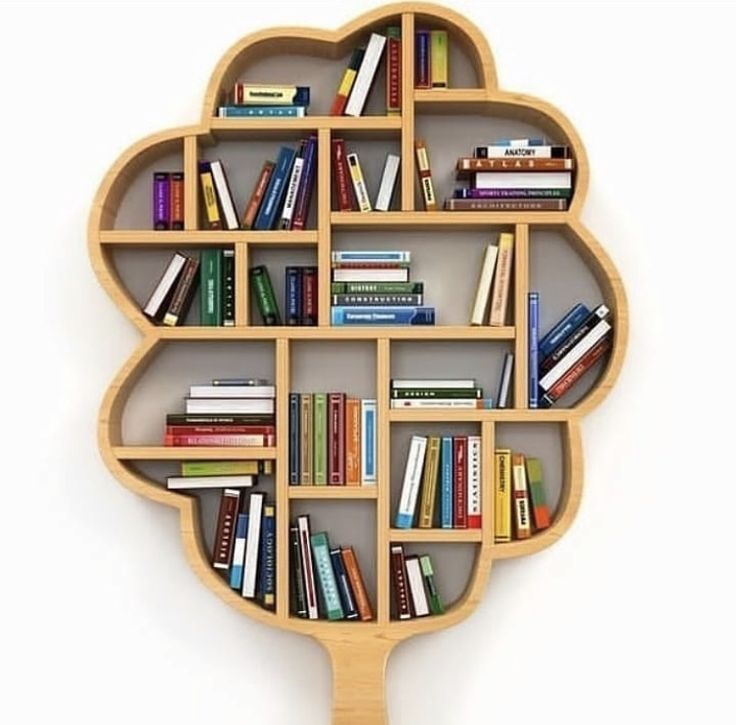 If you don’t have the book collection – or the inclination – to create a full rainbow spectrum, simply color block your shelves to complement your room’s color palette.
If you don’t have the book collection – or the inclination – to create a full rainbow spectrum, simply color block your shelves to complement your room’s color palette.
If you’re organizing a bookshelf with children in mind, professional organizer Kathryn Lord of More to Organising says:
‘Color coordinating your bookshelf means your child can easily put things back. It also means they can find their favorite book without pulling everything out as even before they can read, they know what color their favorite book is’.
5. Reserve prime space for favorite books
(Image credit: Future)
If you're considering reading nook ideas, this is the perfect opportunity to create a smaller group of your favorite books, or those you need access to most regularly, separately from your primary organization system. Position them within easy-reach (middle-section shelves for most, depending on your height) to save you having to find them each time. Keep them separated from the rest with book dividers or use objects and book stacks either side.
Avid book readers might also find this technique useful for grouping not-yet-read books, so they’re easy to find and flick through when looking for something new.
6. Organize books by height
Grouping books of a similar size and height together will give your collection a clean, streamlined look, perfect if you are looking for smart living room bookshelf ideas. However, depending on the look you’re going for (and how functional you want your organization to be) you could have a little fun with different arrangements. Maybe keep tall books on the edges and go shorter in the middle, or alternate shelves starting with the tallest book, then the shortest, and so on.
7. Stick to the two-thirds rule
Ensuring your books have space to breathe is not only good for their shelf life, but also the functionality and style of your display.
‘Crowding books tightly on shelves make them impossible to pull out, while overcrowding can make for a cluttered feel,’ says home organizer Ben Soreff.
According to the experts, this can be avoided by instilling the ‘two thirds rule’: only fill two-thirds of each shelf with books. What you do with the empty space depends on what look you’re trying to achieve. Add in decorative accessories or leave it clear for a minimalist vibe.
8. Build stylish stacks
(Image credit: Future)
Oversized hardbacks can overpower a bookshelf arrangement when arranged standing up, not to mention take up space. Stack them with spines facing outwards, starting with the biggest book at the bottom. If your shelf is at eye-level, choose a book with an attractive front cover to go on the very top.
Stacking is also a good tactic for differentiating types of books, such as non-fiction, recipe or reference books, for example.
9. Leave space for other items
(Image credit: Neptune)
Bookshelves aren’t just for books. Family photos, heirlooms, vases with flowers… anything that brings you happiness when you look at it deserves a designated place.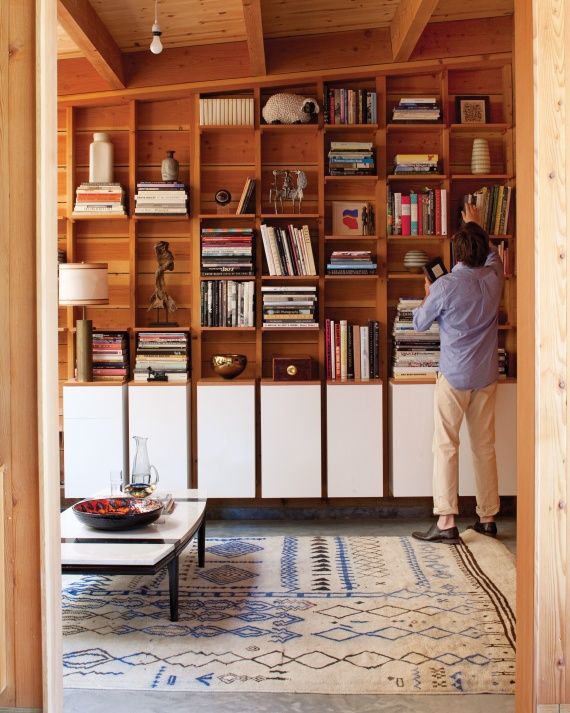
‘Styling can often be an undercover organizational tool for shelving,’ says Heather Hoerzen, design editor at Havenly . ‘Creating a little vignette with a tray, diffuser and pretty faux plant not only sparks joy, but it can also serve as a reminder to put things back as you found them’.
A good rule of thumb is to group items in odd numbers ensuring plenty of space around them. Keep your room’s color palette in mind but try not to worry too much – over-styled bookcases can look a little cold, while meaningful items will automatically inject warmth and personality into the room.
10. Prop up artwork
Adding your favorite art pieces to your bookshelf adds visual impact, turning it into a stylish focal point rather than something that’s purely practical. A propped collection comes with the benefit of no nails, so can be effortlessly transformed on a whim for a whole new look.
Position your most prominent pieces in the center of the shelf and then work outwards with smaller pieces.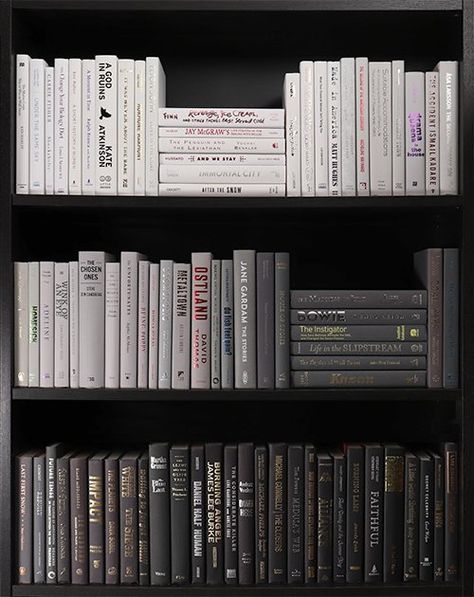 Combining different styles, sizes and colors of picture frames creates a lovely lived-in look, along with postcards and canvases to break it up. Pick out key tones within your prints, or maybe even a theme, to ensure your display feels considered.
Combining different styles, sizes and colors of picture frames creates a lovely lived-in look, along with postcards and canvases to break it up. Pick out key tones within your prints, or maybe even a theme, to ensure your display feels considered.
11. Arrange by style
(Image credit: Brent Darby )
While most libraries like to organize a bookshelf alphabetically, and this tried-and-tested system works wonderfully for those wanting to find a specific author with ease, we sometimes like to throw the rulebook out of the window by arranging our books by the style of the spine. For example, those of us who are more visual might be inclined to remember a book by what the cover or spine looks like, rather than wanting to search alphabetically.
Here, this aesthetically-pleasing space doesn't follow any particular system, yet it still somehow works. After all, our brains are wired differently, so do what is best for you and your family.
12. Match books to the color scheme
(Image credit: Future)
Are you a particularly visual person? Us, too.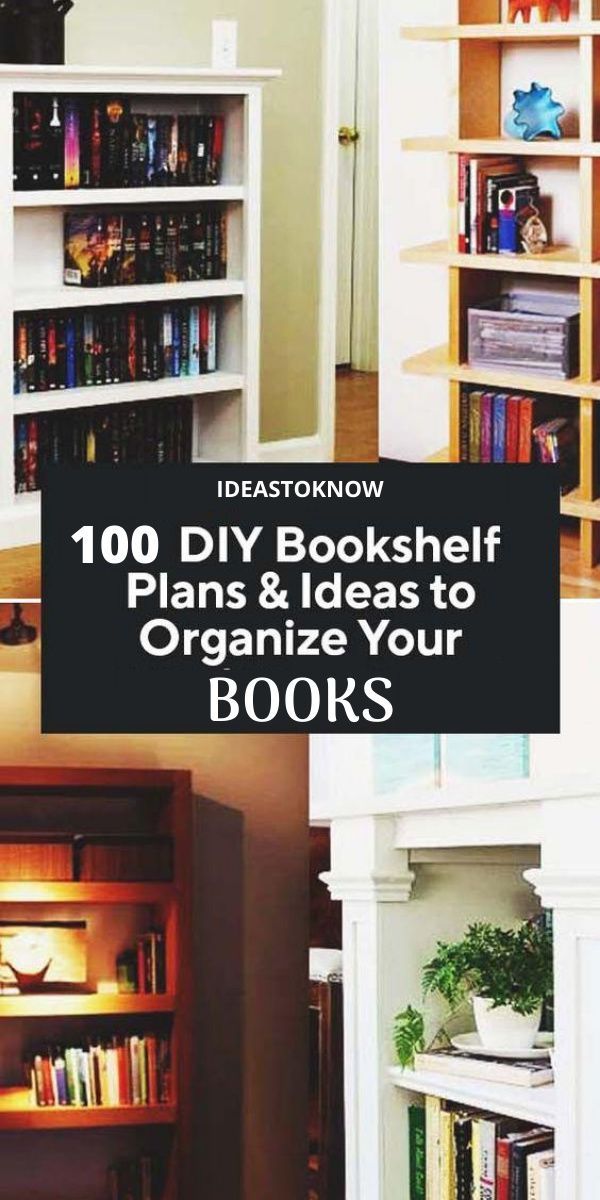 That is why this space works so well; the books seamlessly color coordinate with the rest of the room. There is absolutely nothing wrong with wanting to ensure that your scheme remains cohesive and tailored, especially when covering your books with the same color jackets is so easy to do. The result? A space that looks like something out of a story book.
That is why this space works so well; the books seamlessly color coordinate with the rest of the room. There is absolutely nothing wrong with wanting to ensure that your scheme remains cohesive and tailored, especially when covering your books with the same color jackets is so easy to do. The result? A space that looks like something out of a story book.
13. Leave empty spaces
(Image credit: Future)
Just because you have the space, it does not mean that you need to fill every nook and cranny. This bookshelf is a perfect example of letting a space breathe; hugely important in a home office or bedroom.
I have seen time and time again, that people like to cram as much onto on bookshelf as they can, so once you've done a declutter, think about keeping it simple, especially if your bookshelf looks as beautiful as the one above.
14. Use art to divide books
(Image credit: Future )
Rather than just simply arranging your books on a shelf, think about breaking up the space between genres, authors, colors or styles with art.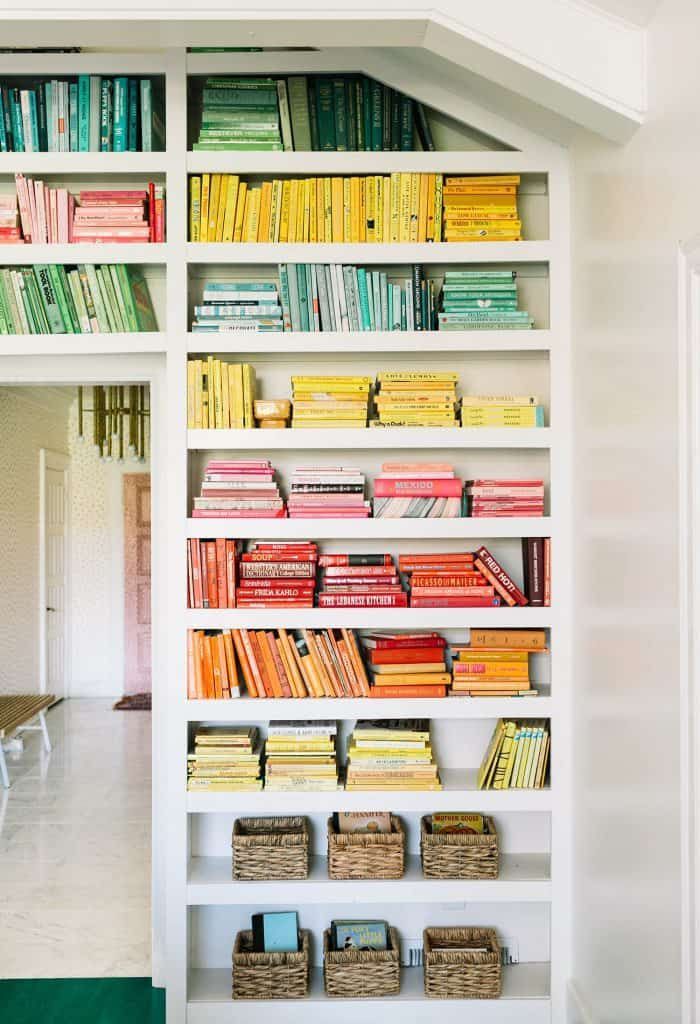 Use prints, objects and vases to add interest and visual break points to rest the eyes and draw attention away from old or tattered books.
Use prints, objects and vases to add interest and visual break points to rest the eyes and draw attention away from old or tattered books.
Here, this bookshelf draws the eye to every single visual breakpoint beautifully and wonderfully stimulates the senses without causing disruption to the central focus; the TV.
15. Place lesser used book on the top shelf
(Image credit: Future )
If you have books that you've read but just can't bear to part with, then consider placing them on the top shelf, just high enough to admire, but also ensuring that they are well out of the way. Keep the lower bookshelves free for books and other objects, like vinyl, and more regularly used items.
What is the best way to organize a bookshelf?
Contrary to popular belief, maximizing space on your bookshelf space does not mean filling every inch with book upon book. Instead, think about clever ways to store books that utilize the space you have in the best way, while still allowing for some empty areas. This will help create a pleasing aesthetic overall, especially important for creating a calm finish, for bedroom bookshelf ideas or when you’re organizing a home office, for example.
This will help create a pleasing aesthetic overall, especially important for creating a calm finish, for bedroom bookshelf ideas or when you’re organizing a home office, for example.
Stacking books rather than lining them up makes the most of vertical space that would otherwise go unused. Start with bigger, heavier books at the bottom and go down in size from there. Alternatively, consider layering two rows of books along one shelf. If you decide to do this, it’s worth investing in shelf risers. Position the back row on the top of the riser for extra visibility and use the cubby hole underneath to store other books that you use less often, or don’t look as nice on display.
Look at using the very top of your bookshelf – could you line it with baskets for extra storage? Also look to see if your shelf heights can be easily adjusted. If so, you could squeeze in an extra shelf at the top to house smaller books or items.
How do I organize a bookshelf?
Organizing a bookshelf in a home is a personal choice and, unless it’s your preference, doesn’t have to follow an established system. However, there are a number of ways you might approach the task.
However, there are a number of ways you might approach the task.
If finding books speedily is crucial, arranging in alphabetical order, or perhaps alphabetical order within subject-specific sections, is a good idea. Of course, if each section isn’t large, then just putting like with like so, for example, interiors books are together, will suffice.
For a stylish display, arranging by color is a popular tactic and you might choose darker spines for lower shelves with colors becoming progressively lighter as shelf height increases.
At an individual shelf level, meanwhile, arranging by height with taller books on each side of the shelf can create a balanced impression.
For interest consider shelving some books horizontally as well as placing them vertically, and show off decorative objects along with books to give the eye plenty to appreciate.
For 10 years, Tara King worked as a Content Editor in the magazine industry, before leaving to become freelance, covering interior design, wellbeing, craft and homemaking.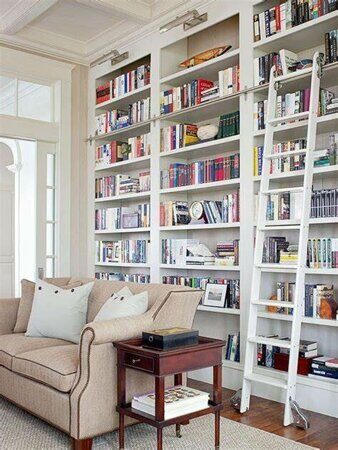 As well as writing for Ideal Home, Style at Home, Country Homes & Interiors, Tara’s keen eye for styling combined with a passion for creating a happy – and functional – family home has led to a series of organization and cleaning features for H&G.
As well as writing for Ideal Home, Style at Home, Country Homes & Interiors, Tara’s keen eye for styling combined with a passion for creating a happy – and functional – family home has led to a series of organization and cleaning features for H&G.
With contributions from
- Jennifer EbertDeputy Editor (Digital)
35 functional and beautiful ways to store books in the interior - Roomble.com
2021-09-04T03:10:00+00:00 2021-09-04T03:13:29+00:00 35 functional and beautiful ways to store books in the interior 2021-09-04T03:10:00+00:00 Do you have problems with the organization of bookshelves - there is not enough space or you want a bright and unusual solution? We present unexpected and interesting projects of "libraries" for modern interiors with space saving: from classic to outrageous 35 functional and beautiful ways to store books in the interior nine0003
Do you have problems organizing your bookshelves - lack of space or want a bright and unusual solution? We present unexpected and interesting projects of "libraries" for modern interiors with saving space: from classic to outrageous
Books for many of us - with all the abundance of television, the Internet, social networks, book readers and other gadgets in our lives - remain an indispensable friend and assistant.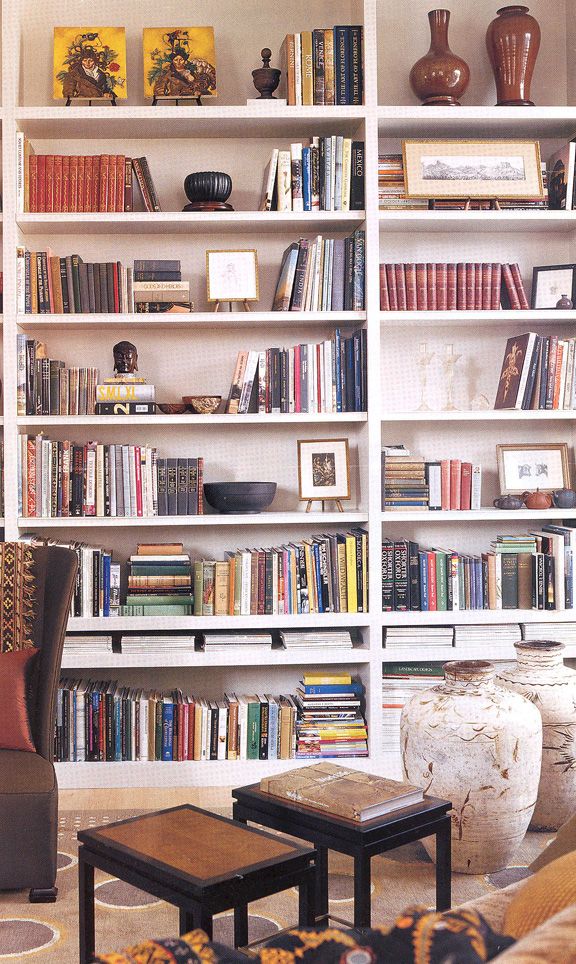 Therefore, talk about the fact that the book has ceased to be a necessity, but is gradually turning into an anachronism, remains talk. To which you react less, the more books you have. nine0003
Therefore, talk about the fact that the book has ceased to be a necessity, but is gradually turning into an anachronism, remains talk. To which you react less, the more books you have. nine0003
The question is different - how to place books in often not the most spacious living quarters? This is true not only for "Khrushchev" or nine-story buildings, but also for suburban housing, where it is much more spacious. After all, it is necessary not only to organize the storage of books, but also to provide easy access to them. And, most importantly, it should be beautiful.
The use of a ladder as a library at the same time is not a new idea, but it is very interesting and varied in its incarnations. The simplest options are easily implemented even without rework and serious hassle. Much of what is offered for review can be used as an addition to an existing interior. Well, if a “big repair” is being started, then it all depends only on the number of books you have and the desire to organize a new place for their storage - beautiful, unusual, convenient.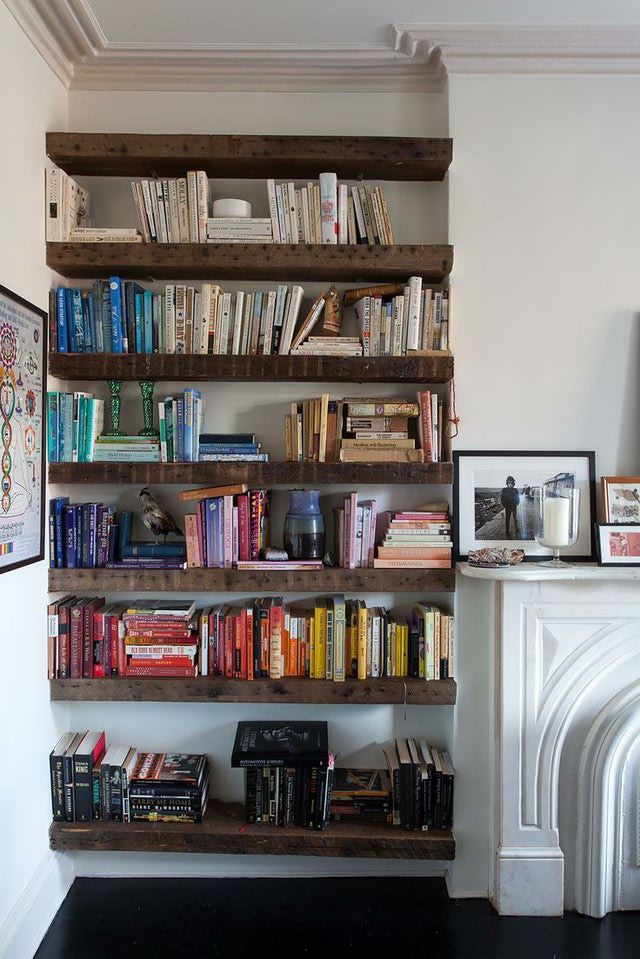 And it doesn't take up space at all. nine0003
And it doesn't take up space at all. nine0003
Our opinion:
- It must be remembered that direct sunlight for books is the last thing they need. Therefore, in all cases when "beauty for" you place a shelf in a room full of light, try not to put collectible items on it. Limit yourself to pocketbooks and glossy magazines. Or a collection of works by the classics of Marxism-Leninism (ask the older generation).
The “classic” book storage scheme that we are accustomed to in a furniture wall or on shelves covering one of the walls is not the only possible one, which is already obvious. One of the brightest steps in this area is an unexpected and ingenious solution to increase the functionality of ordinary interior items by organizing books and magazines in them. The fantasy of designers overflows when this idea begins to be embodied "in the material." We agree that a lot of what is presented is quite realistic to do yourself - or order, based on the option you like the most.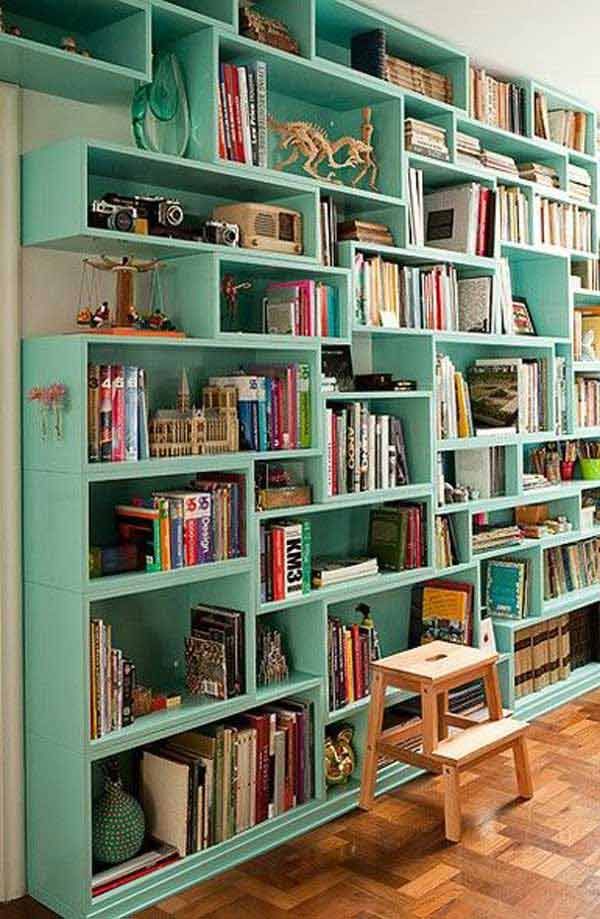 nine0003
nine0003
Both the opening itself (passage) and the space around it are used. Filling a wall with a door or window with bookshelves is a superficial idea. Its attractiveness lies in the ease of implementation and in the most rational use of space. The functionality of the walls adjacent to the door or window, as a rule, is zero in ordinary interiors. Isn't it time to start fighting this unjustified tradition? And we will start with our own housing, which will only benefit from this. nine0003
The idea of a bookshelf as a wooden box with certain proportions, which is mounted on the wall and in which books are stored, has become outdated a long time ago. Unfortunately, manufacturers of mass furniture continue to live in the century before last, and it is rare to find anything original, beautiful and comfortable for sale that continues to be a bookshelf. But the most diverse ways of making bookshelves are possible, which - without losing functionality - will become a bright and memorable element of the interior.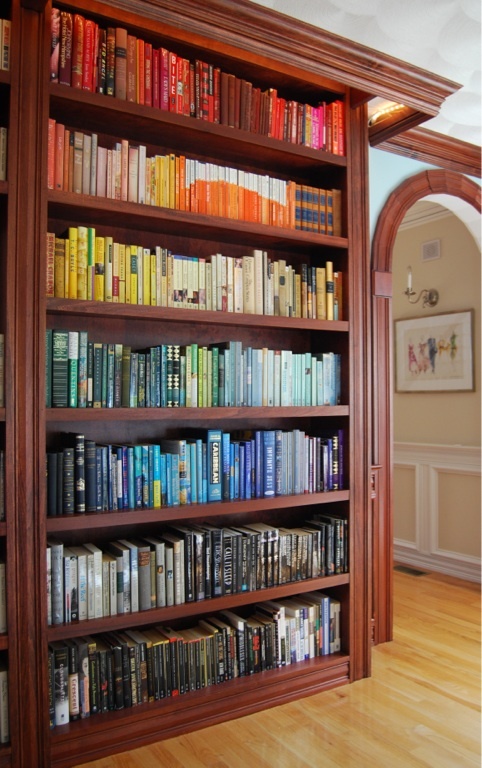 nine0003
nine0003
The options for organizing storage places for a large number of books presented for review first of all cause a smile. And not because it's funny, not at all. The imagination of designers who came up with such unusual solutions is amazing. Agree that there is not a single idea for the sake of an idea, everything is completely functional and very convenient. If you organize something like this at home, then the competition for the possession of this space among family members will be the most serious. nine0003
Greetings from the novels of Alexandre Dumas (and other everyday writers of antiquity, antiquities and secrets), in which a lot of secret passages are hidden just behind the wall panels and bookcases. In our realities, such a move is appropriate, first of all, for turning a passage room into an impassable one. Quite often this is very, very relevant, but here is such an idea! And we hide the shortcomings of the apartment, and we organize a library place. Well, it's not worth talking about the emotions of those who see it. nine0003
Our opinion:
— In order to realize the idea of a pivoting door-shelf, a professional is needed. Such a design is a rather complex engineering structure, and for its normal operation without distortions, a powerful frame system is needed, masked by a wooden cladding.
The traditional library wall, filled with cabinets or shelves, can be transformed in the most incredible way thanks to the designer's imagination and conditions "in place". From strict geometry to artsy empire style, from bright pop art to gloomy ethnic style - a wall with books can fit into any style. You just need to think a little and choose what you like the most. nine0003
pinterest.com
Share:
Rate this article:
Thank you for your rating! Want to leave a comment?
no send
Thank you for your vote.
Follow us:
Follow us on Facebook
Follow us on Vkontakte
20 bookshelf design ideas and smart space organization
They hold books and help us to be organized. They are bookshelves, and without them, our homes would be filled with piles of books, and they can be not only functional, but also beautiful. nine0003
They are bookshelves, and without them, our homes would be filled with piles of books, and they can be not only functional, but also beautiful. nine0003
What if decorating the bookshelves is just as important as decorating the living room? Below you will find our tips for decorative finishing, complete with photos of illustrative examples. You must find an idea that suits your design needs. Who knew that books could be seen as decoration?
Bookshelf Display Strategies
We start with some bookshelf basics. When you are planning your interior, consider the function of the shelf. Do you need a lot of books, or is there room to highlight the treasures of interior decor? nine0003
Idea #1: Matching books with decorative items
If you have space, use some decorative items. Vases, figurines and art reproductions as shown below. Notice how the repetition of bright blue and white elements helps bring the interior together.
Idea #2: Creating Symmetry
A sense of balance is powerful, and symmetry can really connect a room.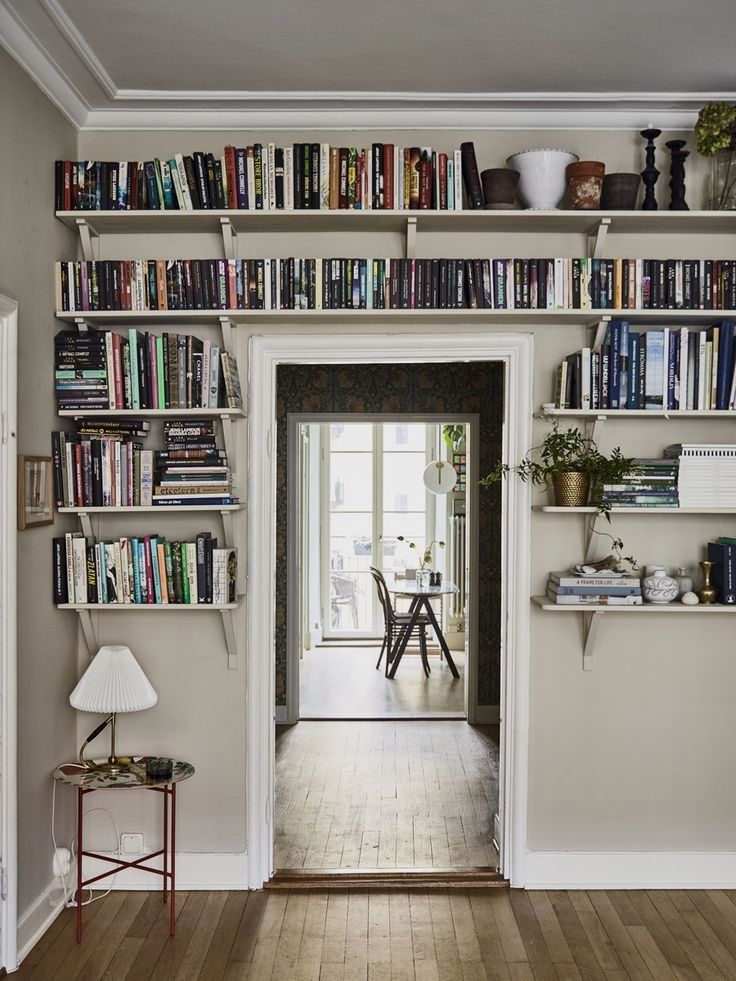 In the display below, notice how the books, vases and figurines are arranged on the shelves. You will not see one side filled with books, and the other gaping with emptiness. nine0003
In the display below, notice how the books, vases and figurines are arranged on the shelves. You will not see one side filled with books, and the other gaping with emptiness. nine0003
This stacking strategy can be used on a single bookcase with multiple shelves. Make sure large items are balanced with other large items and there is no empty space left.
Idea #3: Leave some empty space
About the empty space... If you want to leave part of the shelf empty, get the effect of empty space. Smaller rooms can benefit from this minimalist look, as clutter can make interiors appear smaller than they are. On the contrary, a little emptiness creates the illusion of a large space! nine0003
Preparing books
Now let's look at the books themselves. Since the purpose of a bookshelf is to store reading materials, let's look at ways to display them
Idea #4: Add a slanted book design
Sure, you can arrange the books vertically, one after the other, but wouldn't it be interesting to change the design? Try tilting the books and you'll get a very different look.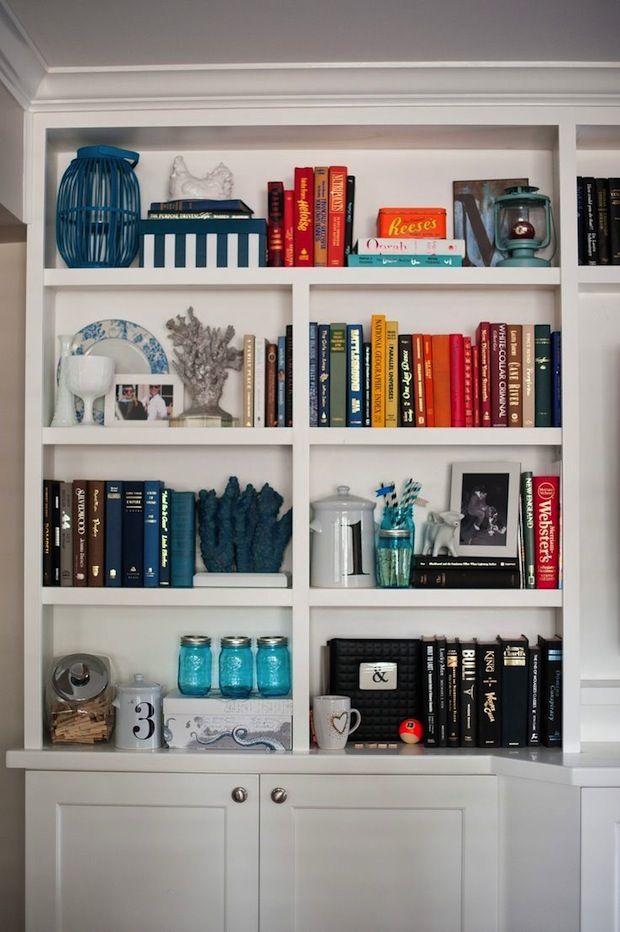 In the room below, the books are arranged obliquely, far from the center of each compartment of the shelf, in connection with this, there is a place, in the middle, for decorative elements. nine0003
In the room below, the books are arranged obliquely, far from the center of each compartment of the shelf, in connection with this, there is a place, in the middle, for decorative elements. nine0003
Idea #5: A stack of books for variety
You can arrange the books at an angle and stack them. Stacking books horizontally creates a modern look and adds variety, and is a good alternative for a room where there is nothing but books.
Bookshelf design selection
Now we will talk about the color design of the bookshelf. Whether you're looking to bring some much-needed revitalization to a space, or you're looking to save your prostate, here are some suggestions for choosing shades for your bookshelf. nine0003
Idea #6: Use a limited color palette
If the room is simple, use a selective color palette. Pictured below is the Domino Tema bookshelf, modern and elegant with white, brown and metallic accents.
Idea #7: Book cover in a single color
If monochromatic design is your preference, try covering your books with identical covers.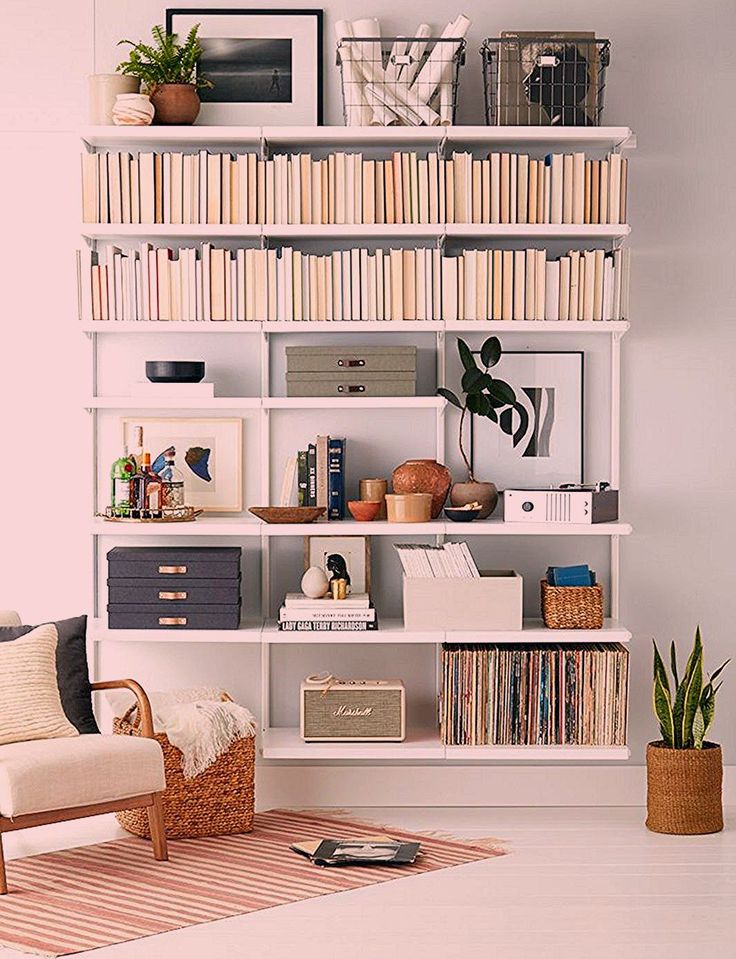 Notice how white is preferred on this bookcase, the measurement is achieved by varying the hues. nine0003
Notice how white is preferred on this bookcase, the measurement is achieved by varying the hues. nine0003
Idea #8: Organize books by color
If you prefer to see the title of your books, arrange them with the bindings facing out! But try arranging them by color...rainbow colors can really spice up a room, adding direction to shelves full of hardbacks and paperbacks.
Idea #9: Create a Gradient Effect
Another color matching choice: achieving a gradient effect, arranging the books so that their color fades and intensifies. Repeat grouping by color from row to row as shown below on the bookcase. One little surprise: this "bookshelf" is actually a wallpaper! nine0003
Idea #10: Using books as a decorative color
We say that books blend in with taste, why not use them as a decorative color? On the bookshelves below, yellow, green, red and turquoise books complement the neutral space.
Make room for other items
It's time to reconsider our non-book spaces.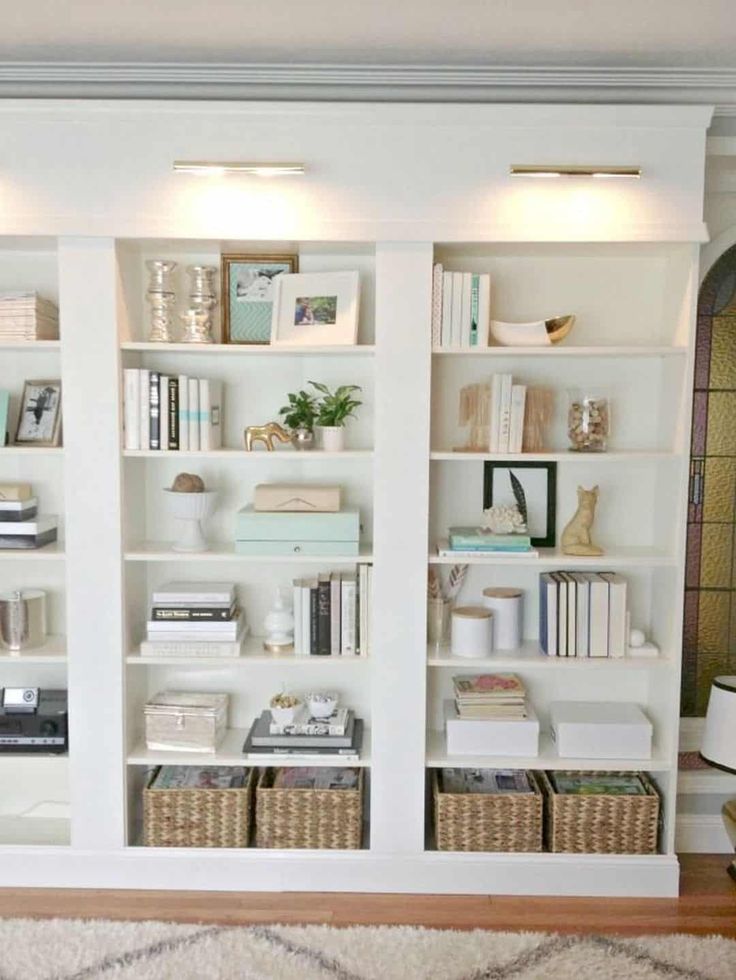 With books carefully placed on the shelves now that we're done, let's look at other ways to make your bookshelf stand out. nine0003
With books carefully placed on the shelves now that we're done, let's look at other ways to make your bookshelf stand out. nine0003
Idea #11: Hide clutter in boxes
We start with some practical advice. If your shelves need to store documents or other items that should not be visible, they can be hidden in a series of elegant boxes, as shown below. To maintain style, stick to one color.
Idea #12: Use uniform bindings
We propose the idea of uniformity in binding. Do you have papers on your shelf instead of books? In this next space, office documents are neatly placed in a series of white-bound folders that lie horizontally. nine0003
Idea #13: Display a decorative art collection
Do you have a collection that needs to be shown? Perhaps your bookshelf is the perfect place for this! Pottery and shells are popular collectibles that bring life to a setting, like this bird theme shown below. Remember, in the grouping of the collection, there must be a style.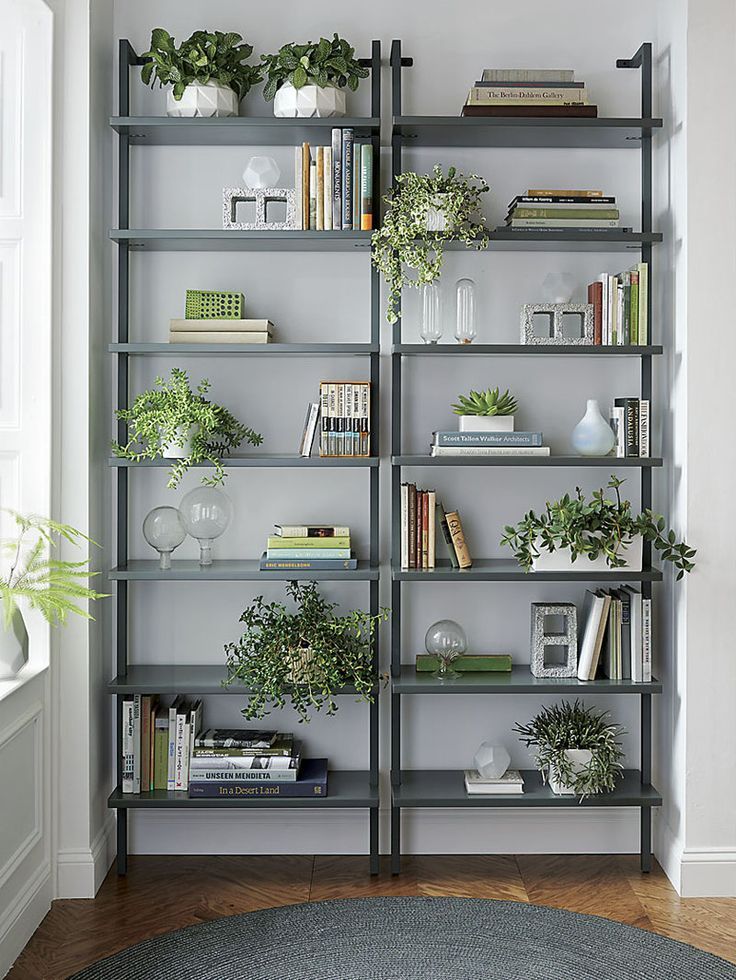
Idea #14: Create a sense of depth with art
Use artwork to achieve a sense of depth on your shelves. Notice how the paintings are framed in this next room, creating a backdrop for collectibles and books, layered to create a clear foreground, middle, and background. nine0003
Bookshelf for decoration
What if a good bookshelf design caught your attention? Below we look at ways to update your bookcases...
Idea #15: Paint the back of your bookshelf
Paint the inside of your bookshelf. It's very simple and is the peak of the design takeoff in recent years, as a project of hobbyists who don't want to use a bright paint color for the whole room, and get a bold color by introducing it through a bookshelf. Plus, the vibrant coloring makes the contents of the shelf stand out! nine0003
Idea #16: Paint the top, bottom and side inside of the shelf
If your choice of furniture is a shelving unit that doesn't have a paintable back, you can paint the inside of the shelves. On the bookshelf below, notice how painting the interior of just two compartments turns the shelf into a modern piece of art.
On the bookshelf below, notice how painting the interior of just two compartments turns the shelf into a modern piece of art.
Idea #17: Wallpaper Shelf Interior with Bold Geometric Print
Wallpaper breathes new life into bookshelves, especially when a bold geometric pattern is used along the back interior wall. To properly use the wallpaper, check out the full Feathers Flights tutorial. nine0003
Idea #18: Use wallpaper with a metallic sheen
Metal accents add sparkle to your shelf and the space it sits on. Choosing metallic wallpaper as a backdrop for glossy décor items transforms the shelf into a shimmery, vibrant showpiece.
Unforgettable bookshelves
Sometimes a well-designed bookshelf becomes a memorable and centerpiece of a room. The shelf itself stands out with its appearance, making your creative work more attractive...
Idea #19: Choose an architecturally interesting bookshelf
Arched bookshelves below, add movement to the space.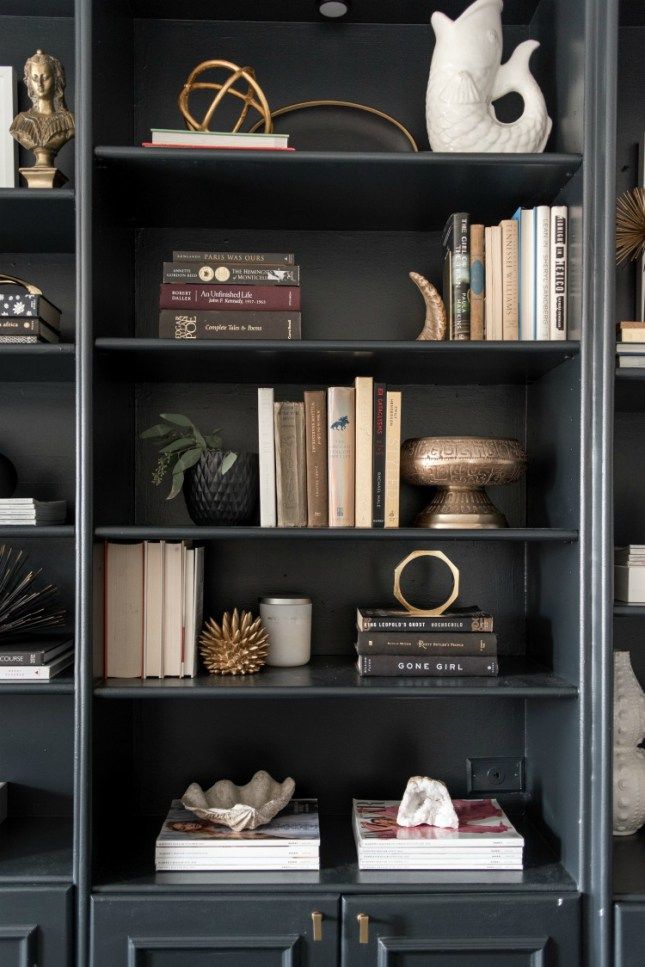 Their stunning form is enhanced by selected books in a color scheme of white and cream. On the other hand, on these extraordinary bookshelves, any arrangement of books and decor would be amazing!
Their stunning form is enhanced by selected books in a color scheme of white and cream. On the other hand, on these extraordinary bookshelves, any arrangement of books and decor would be amazing!
Idea #20: Choose a bookshelf that is a work of art
Speaking of art, it's hard to go wrong when choosing a museum-worthy bookshelf. In Moroccan style, the Zelli bookshelf (photo below) is a prime example. nine0003
As you already understood, it is impossible to combine all the ideas described above! You cannot fill a shelf with books and leave a lot of empty space. You also can't showcase your décor collection by filling a shelf with just books. Bookshelves should meet your specific design needs.
If you don't have many books, use the shelves as a display of your favorite collectibles. If you are using shelving to store a large collection of books, then try filling in the shelves according to the color distribution and planned design. With a little effort, even the most practical bookcases can add personality to your space.
